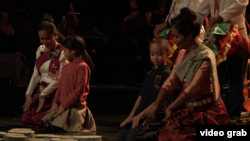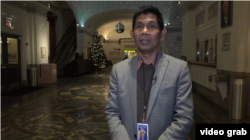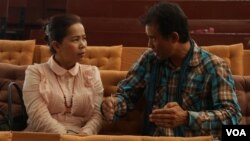Quietly, Bonna Neang Weinstein wept. Her husband, Howard Weinstein, sitting next to her, held her hand, comforting her.
“It reminded me of everything and myself,” she said of a December 15 performance of “Bangsokol: A Requiem for Cambodia” at the Next Wave Festival at the Brooklyn Academy of Music (BAM). The first major symphonic work to remember the deaths of an estimated 1.7 million Cambodians under the rule of the Khmer Rouge regime undid Weinstein, a survivor, who arrived in the U.S. in 1984.
“I could not believe that I lived through that,” she said, her eyes filling with tears.
The production is the first collaboration between composer Him Sophy and Oscar-nominated filmmaker Rithy Panh, who directed and designed the production.
Both artists survived the Khmer Rouge, which by some estimates killed 90 percent of Cambodia’s artists.
The two are in the forefront of Cambodia’s cultural renaissance, a movement to revive and preserve the ancient arts that were nearly excised, while educating new generations about their cultural heritage. Because of the Khmer Rouge genocide from 1975-1979, half of Cambodia’s population is younger than 25.
The production presented in New York is also aimed at the Cambodian diaspora. It has played on tour in Australia, where the Sydney Morning Herald described it as “light after utter darkness, a promise of resurgence...” and, after sold-out performances in Boston, it is headed to the Philharmonie de Paris next year before opening in Cambodia in 2019, the 40th anniversary of the end of the Khmer Rouge era.
Named after ceremony
“Bangsokol” is named after a ceremony performed at Cambodian funerals. A bangsokol is both the white cloth placed over the body of the deceased and the act of its removal, which signified the passage into the next life, where the spirits of the dead find rest. Bangsokol is also remembering the dead at a watt, the Buddhist temple, with prayer and offerings.
Each audience member found a bangsokol draped across their seat with a note: “We invite you to place this shroud around your shoulders for the duration of the performance.”
“Bangsokol” weaves Khmer traditional music enhanced by a Western orchestra and a Taiwanese chorus performing the libretto by Trent Walker.
Throughout the one-hour production, archival footage — the faces of Cambodian refugees and Khmer Rouge victims, black-clad Cambodians working in fields — flickered across three flat screens hung high behind the performers. Footage of aerial bombings was followed by a clip of then-U.S. President Richard Nixon saying, “Cambodia is the Nixon Doctrine in its purest form.”
“Whatever the film showed, it took me there,” Bonna Neang Weinstein said. “It has been more than 30 years, almost 40 years, but I still dream that I am in the Pol Pot regime.”
For many in the audience, the power of the past showed as quick swipes with damp tissues wiping away silent tears.
“If I’d know this was about the Khmer Rouge, I would not have come,” said a weeping To Voeun, 79, of Alexandria, Virginia. The Khmer Rouge killed her husband, leaving her to raise seven children alone, two of whom remain in Cambodia.
For Bonna Neang Weinstein, the owner of the Khmer Art Gallery in Philadelphia who attended “Bangsokol” with her husband and her three children, the Nixon clip hit home.
She explained: “I cried because I am hurt that the U.S. government bombed my country,” an event that many believe gave rise to the Khmer Rouge.
‘I cannot let it go’
“The U.S. has not admitted anything and not even apologized to us,” said Weinstein, who lost eight family members to the Khmer Rouge. “It mentions at the end ‘Let it all go.’ But I cannot let it go because the perpetrators have not acknowledged their guilt and apologized.”
Sophy Him, who composed the rock opera Where Elephants Weep, told VOA Khmer that his requiem does more than commemorate those who died under the Khmer Rouge.
“We remember the deaths, but also wish and encourage people in the world to have hope and love each other,” said Sophy Him, who lost two older brothers to the regime.
“This performance is for all people in the world who have suffered from genocides and wars,” he said. “This performance is also a warning to the world about the impact of war and genocide.”
That warning was not lost on Jonathan Hulland, a senior program officer at the American Jewish World Service in New York City, who told VOA after the performance that by putting on the white shroud, he felt he was part of the performance.
Hulland, who has been to Cambodia four times, most recently in October, appreciated the warning implicit in the performance.
“I felt some shame and some guilt,” said Hulland, who was born in the United Kingdom and is now an American citizen. “I am an American now, and I do feel like this country has such a responsibility for what happened.”
Joseph Melillo, BAM’s executive producer, said, “BAM plays a very significant role, not only here in New York City, but in this country of introducing to our culture, the work of other cultures.”
Melillo, who has been to Cambodia twice, said he decided to bring “Bangsokol” to BAM because of Phloeun Prim, the executive director of Cambodian Living Arts (CLA), “who has a clear vision of what he wants for his country.”
The performance was commissioned by CLA, a nonprofit group that works to support the revival of traditional art forms.
Mary Read, who serves on the CLA board of directors, said, “Bangsokol” showed “that there is compassion.”
“Art comes to the heart,” said Read, an Australian known internationally for her Sydney fashion boutique and online store. “By healing the heart, you can heal the spirit of the country.”
The performance ends with Chhay Yam, a joy-filled Cambodian dance accompanied by singing. Two Cambodian-American children of the production’s volunteer helpers participated, learning the steps and how to play traditional musical instruments.
Hollywood luminary Angelina Jolie, who holds Cambodian citizenship and directed First They Killed My Father with Rithy Panh, recently saw the performance with her children Maddox Jolie-Pitt, whom she adopted as a baby in Cambodia, and Shiloh Jolie-Pitt. They all wore white shirts and black pants, traditional Khmer funeral dress.
Jolie told VOA after the performance, “I think this was a deeply moving performance. I think it is brilliantly done. I think it is very powerful. It put you into a meditation. It’s like an hourlong prayer to pay respect, to remember, and to help us think of Cambodia the past, the ancient past, the more recent past, the present, and take us forward into a more hopeful future.”











